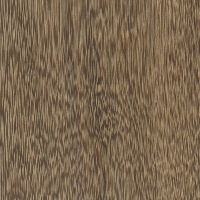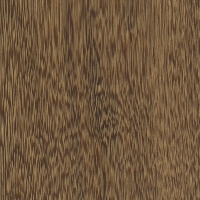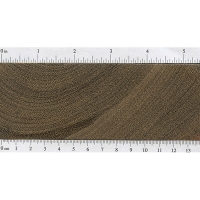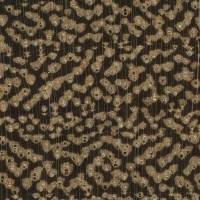 |
Common Name(s): Brownheart, Wacapou Scientific Name: Vouacapoua americana Distribution: Northeastern South America Tree Size: 65-100 ft (20-30 m) tall, 2-3 ft (.6-1 m) trunk diameter Average Dried Weight: 62 lbs/ft3 (925 kg/m3) Specific Gravity (Basic, 12% MC): .78, .93 Janka Hardness: 1,880 lbf (8,370 N) Modulus of Rupture: 21,820 lbf/in2 (150.5 MPa) Elastic Modulus: 2,586,000 lbf/in2 (17.83 GPa) Crushing Strength: 11,590 lbf/in2 (79.9 MPa) Shrinkage: Radial: 4.6%, Tangential: 6.7%, Volumetric: 11.9%, T/R Ratio: 1.5 |
Color/Appearance: Heartwood is a medium to dark brown, sometimes with a reddish hue. Lighter brown lines (from parenchyma) mixed throughout give a contrasted appearance. Pale sapwood is clearly demarcated from heartwood.
Grain/Texture: Grain is straight to slightly irregular, with a uniform medium texture and moderate natural luster.
Endgrain: Diffuse-porous; solitary and radial multiples; large pores in no specific arrangement, few; mineral/gum deposits occasionally present; parenchyma lozenge, winged, confluent, and marginal; narrow rays, spacing normal.
Rot Resistance: Rated as very durable; good insect resistance.
Workability: Moderately difficult to work on account of its density. Tends to blunt cutters. Turns, glues, and finishes well.
Odor: No characteristic odor.
Allergies/Toxicity: Although severe reactions are quite uncommon, Brownheart has been reported to cause skin irritation. See the articles Wood Allergies and Toxicity and Wood Dust Safety for more information.
Pricing/Availability: Brownheart is only infrequently exported. It’s much more commonly used within it’s natural range for heavy exterior construction and for interior furniture. Small turning blanks are sometimes available at a moderate to high price for an imported hardwood.
Sustainability: This wood species is not listed in the CITES Appendices, but is on the IUCN Red List. It is listed as critically endangered due to a population reduction of over 80% in the past three generations, caused by a decline in its natural range, and exploitation.
Common Uses: Flooring, heavy construction, turned objects, furniture, and cabinetry.
Comments: Both strong and beautiful, Brownheart has been harvested and used for both utility and aesthetic purposes throughout its natural range. Brownheart has been formerly classified in the Andira genus, and is closely related to Partridgewood (and the wood also bears a close resemblance visually as well.)
None available.





I had the good fortune to get hold of a brownheart cookie to work on, hard wood to turn but the colour and grain ar worth the effort
Hi! I’ve recently become super interested in identifying wood. As a wood worker I’ve accumulated an array of pieces over the years and never known what some of them are.
This is one sample that has always alluded me but your site may have helped me crack the code:
Through the refining tool (which is fantastic by the way) I think I’ve possibly narrowed it down to Brownheart but still not 100%. Any thoughts?
I think you’ve got the right idea. Overall, the type of grain that’s seen in this wood could be classified as “partridge” — of which Andira inermis is the original commercial wood with that name. https://www.wood-database.com/partridgewood/
I would say if the wood is less than 15 years old, it’s more than likely brownheart, but if it’s several decades old, partridgewood may also be another candidate. I haven’t looked deep enough into the various “partridge” woods to know off the top of my head how to distinguish them. Perhaps that’s a future article for later on.
I’ve definitely got to get some sort of magnifier. I guess if 10x magnification is a standard; that will help get scale for understanding pore and ray sizes.
With these boards, it’s impossible to know how old they are; they came out of someone’s loft and I saved them just before they went in the skip.
end grain photo too
Believe we have Brownheart from referencing your book , great tool.